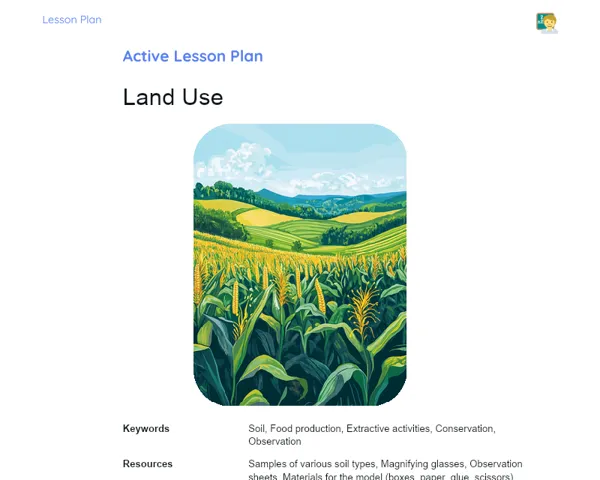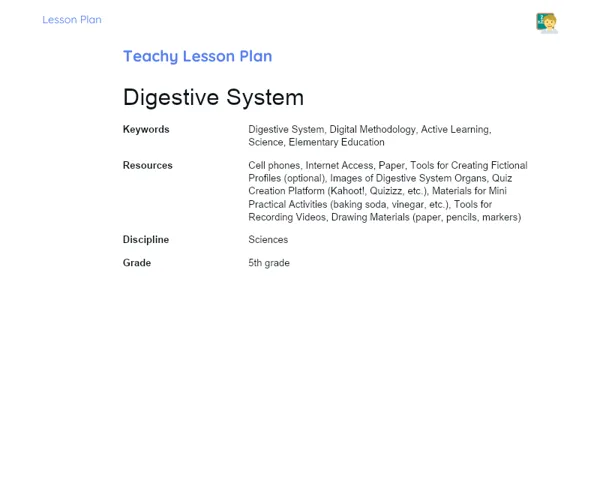Lesson Plan Teknis | Sound Production
| Palavras Chave | Sound production, Sound propagation, Sound perception, Hands-on activities, Experiments, String telephone, Sound waves, Acoustic engineering, Sound technicians, Communication, Science, 3rd grade education |
| Materiais Necessários | Short video about sound production and transmission, Tuning fork, Container of water, Computer and projector, Plastic cups (2 per group), String (about 2 meters per group), Tools for making holes in cups (needles or scissors), Papers and pencils for taking notes |
Objective
Duration: 10 - 15 minutes
This stage aims to familiarize students with the concept of sound production in a practical and relatable way. It's crucial for students to grasp not only the academic theory but also how these ideas play out in real life, particularly in scenarios that may be pertinent to their future careers. Focusing on developing practical and experimental skills equips students to understand and apply their knowledge in everyday situations as well as in the job market.
Objective Utama:
1. Understand how sound is created and the various sources it comes from.
2. Examine how sound travels through different materials.
3. Recognize how humans perceive sound.
Objective Sampingan:
- Enhance observational and analytical skills.
- Encourage curiosity and critical thinking about everyday phenomena.
Introduction
Duration: 10 - 15 minutes
This stage is designed to introduce students to the concept of sound production practically. It's essential for them to comprehend not just the theory but how these concepts apply to real-world scenarios, especially in fields relevant to their future careers. Emphasizing the development of practical skills helps students to apply their knowledge in everyday situations.
Curiosities and Market Connection
Did you know that the speed of sound is different in various materials? In air, it travels at approximately 340 meters per second, but in water, it can reach up to 1,480 meters per second! This difference is vital for careers like acoustic engineering, where professionals design concert halls and recording studios to achieve optimal sound quality. Sound technicians also rely on this knowledge to create immersive sound effects for movies and video games.
Contextualization
Sound production is a part of our everyday existence, whether it’s the buzzing of an alarm clock in the morning, the commotion of traffic, or the tunes we enjoy. Grasping how sound is generated and transmitted allows us to understand our surroundings better and appreciate the scientific principles behind something so commonplace, yet captivating. Sound is energy that travels in waves and is essential for communication, entertainment, and many other aspects of our lives.
Initial Activity
Kick off the class by showing a short video (2-3 minutes) that demonstrates how sound is made and travels through different mediums. A good example would be a video of a tuning fork creating visible sound waves in a container of water. After watching, pose an engaging question: 'How do you think sound makes its way to our ears?' Allow students a moment to discuss their thoughts.
Development
Duration: 50 - 55 minutes
This stage aims to deepen students' grasp of sound production, transmission, and sensation. Hands-on activities will enable students to see theoretical concepts in action, enhancing understanding and retention. Reflection and exercises will reinforce learning and encourage critical contemplation regarding the application of these ideas in various careers.
Topics
1. How sound is created
2. Travel of sound through various materials
3. How humans interpret sound
Thoughts on the Subject
Encourage students to ponder how sound production and transmission impact their daily lives and how different careers use knowledge about sound. Ask them to imagine life without sound or with varying sounds. Prompt them to consider the sources of sound around them and the importance of sound perception for effective communication and safety.
Mini Challenge
Crafting a String Telephone
Students will create a string telephone to investigate how sound travels through a solid medium.
1. Divide the class into groups of 3-4.
2. Provide each group with two plastic cups and a piece of string approximately 2 meters long.
3. Instruct students to make a small hole in the bottom of each cup.
4. Guide them in threading the string through the holes and tying knots on the inner ends to secure it.
5. Instruct the students to pull the string taut and have one group member speak into one cup while another listens through the other.
6. Encourage them to experiment with different lengths of string and observe how it affects the sound quality.
To showcase how sound travels through solid mediums and explore how tension and the length of the string influence sound transmission.
**Duration: 30 - 35 minutes
Evaluation Exercises
1. Explain how sound is generated and give two examples of sound sources.
2. Describe the process of sound transmission through air, water, and solids.
3. Draw a diagram illustrating how sound moves from the environment to human ears.
4. List three professions that rely on sound knowledge and explain their applications.
Conclusion
Duration: 10 - 15 minutes
The intent of this final stage is to reinforce learning by connecting theory and practice while emphasizing the significance of studied concepts for everyday life and future careers. Additionally, it encourages critical reflection and the sharing of experiences, enriching collective knowledge.
Discussion
Stimulate a discussion among students about their learnings throughout the lesson. Query them on how sound production and transmission relate to daily life and various careers. Encourage them to share their experiences with the string telephone activity and consider how different materials influence the sound quality transmitted. Additionally, discuss how the exercises helped reinforce their understanding and how they might apply these concepts in real-life situations.
Summary
Summarize the key points discussed during the lesson: how sound is produced, how it moves through various mediums, and how humans perceive it. Highlight the practical activities conducted, like crafting the string telephone, and how they demonstrated the theoretical concepts discussed.
Closing
Explain to students why it's important to understand sound production and transmission for everyday life and for different careers. Emphasize its relevance in fields such as acoustic engineering, music production, and sound design in films and gaming. Express gratitude for their participation and reinforce the idea that science is integrated into many aspects of life, encouraging them to keep exploring and learning about their surroundings.


